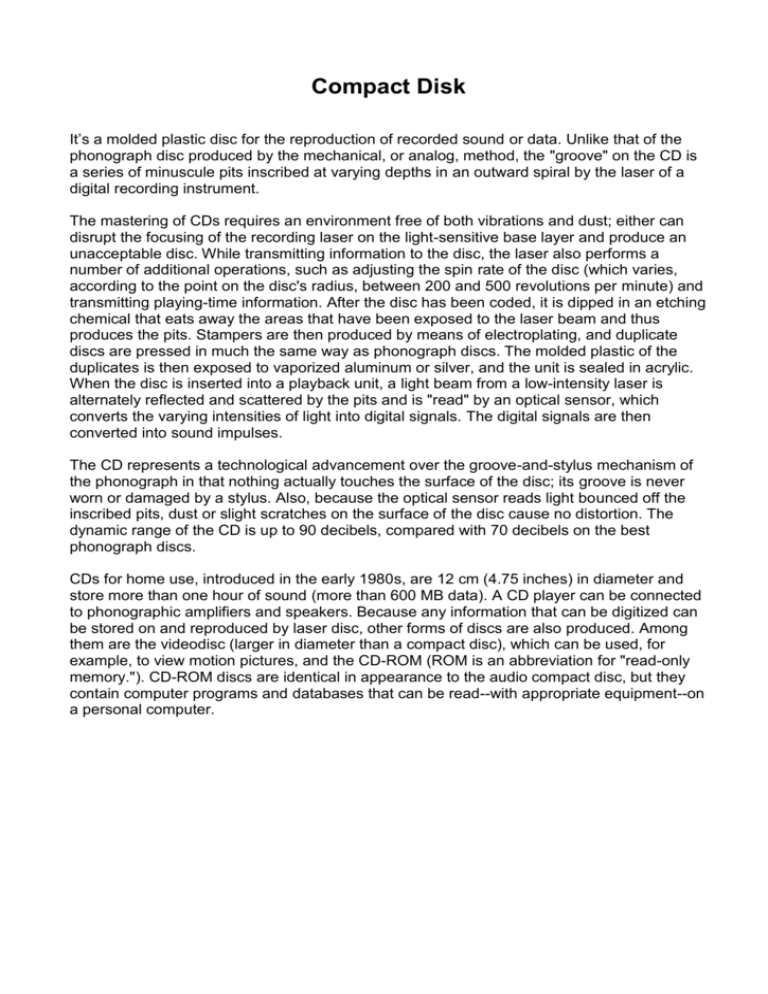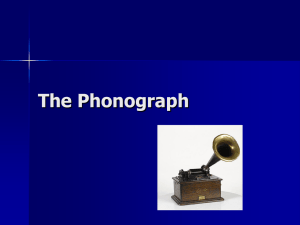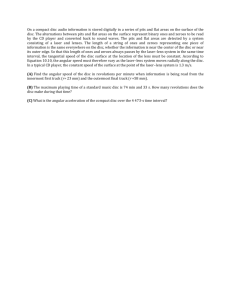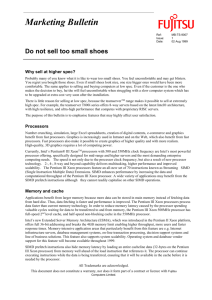Compact Disk
advertisement

Compact Disk It’s a molded plastic disc for the reproduction of recorded sound or data. Unlike that of the phonograph disc produced by the mechanical, or analog, method, the "groove" on the CD is a series of minuscule pits inscribed at varying depths in an outward spiral by the laser of a digital recording instrument. The mastering of CDs requires an environment free of both vibrations and dust; either can disrupt the focusing of the recording laser on the light-sensitive base layer and produce an unacceptable disc. While transmitting information to the disc, the laser also performs a number of additional operations, such as adjusting the spin rate of the disc (which varies, according to the point on the disc's radius, between 200 and 500 revolutions per minute) and transmitting playing-time information. After the disc has been coded, it is dipped in an etching chemical that eats away the areas that have been exposed to the laser beam and thus produces the pits. Stampers are then produced by means of electroplating, and duplicate discs are pressed in much the same way as phonograph discs. The molded plastic of the duplicates is then exposed to vaporized aluminum or silver, and the unit is sealed in acrylic. When the disc is inserted into a playback unit, a light beam from a low-intensity laser is alternately reflected and scattered by the pits and is "read" by an optical sensor, which converts the varying intensities of light into digital signals. The digital signals are then converted into sound impulses. The CD represents a technological advancement over the groove-and-stylus mechanism of the phonograph in that nothing actually touches the surface of the disc; its groove is never worn or damaged by a stylus. Also, because the optical sensor reads light bounced off the inscribed pits, dust or slight scratches on the surface of the disc cause no distortion. The dynamic range of the CD is up to 90 decibels, compared with 70 decibels on the best phonograph discs. CDs for home use, introduced in the early 1980s, are 12 cm (4.75 inches) in diameter and store more than one hour of sound (more than 600 MB data). A CD player can be connected to phonographic amplifiers and speakers. Because any information that can be digitized can be stored on and reproduced by laser disc, other forms of discs are also produced. Among them are the videodisc (larger in diameter than a compact disc), which can be used, for example, to view motion pictures, and the CD-ROM (ROM is an abbreviation for "read-only memory."). CD-ROM discs are identical in appearance to the audio compact disc, but they contain computer programs and databases that can be read--with appropriate equipment--on a personal computer. GLOSSARY amplifier - an electronic device (as in a stereo system) for amplifying voltage, current, or power digital signals - signals in the form of numerical digits digitized - converted data to digital form read-only memory - small computer memory that contains special-purpose information (as a program) which cannot be altered--called also ROM decibel - a unit for expressing the relative intensity of sounds on a scale from zero for the average least perceptible sound to about 130 for the average pain level groove-and-stylus mechanism – that is mechanism which read “groove” like zero(0) and “stylus” like one(1) optical sensor - a device that responds to a physical stimulus (as heat, light, sound, pressure, magnetism, or a particular motion) and transmits a resulting impulse (as for measurement or operating a control) Questions 1. What kind of information you can store on the CD? _________ and _________ 2. Which is the average spin rate of the compact disk? Between ________ and __________ revolutions per minute. 3. What’s the name of the mechanism which is use in CD reading and writing? _____________________________ 4. What’s the dynamic range of CDs? up to ________ decibels 5. When is introduced the CD? ________ 6. What’s the diameter of the CDs for home use? ________ cm







